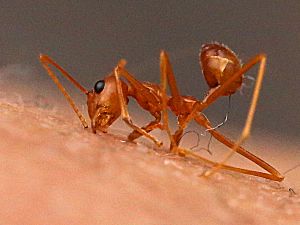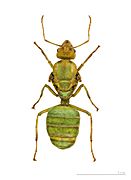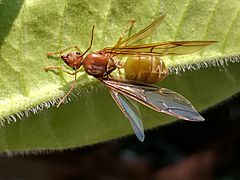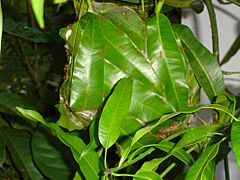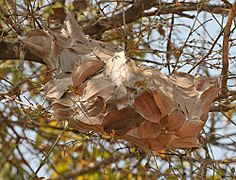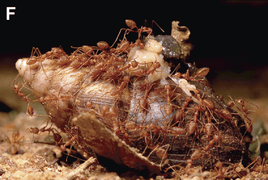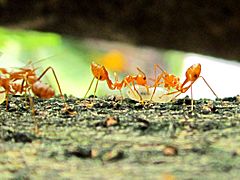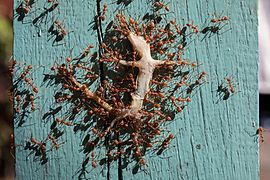Oecophylla smaragdina facts for kids
Quick facts for kids Oecophylla smaragdina |
|
|---|---|
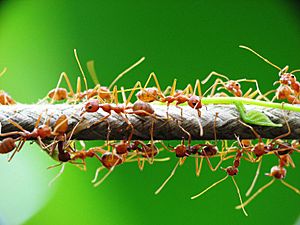 |
|
| Workers | |
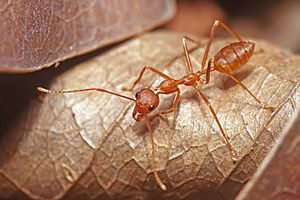 |
|
| Scientific classification | |
| Genus: |
Oecophylla
|
| Species: |
smaragdina
|
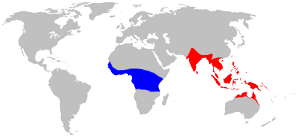 |
|
| Oecophylla range map. O. longinoda in blue, O. smaragdina in red. | |
Oecophylla smaragdina are amazing ants often called weaver ants, green ants, or green tree ants. They live in warm, tropical parts of Asia and Australia. These special ants build their homes, called nests, high up in trees. They make these nests by carefully stitching leaves together using silk from their baby ants (larvae)!
Contents
Meet the Weaver Ants!
Weaver ants come in different sizes and have different jobs in their colony.
Worker Ants
Most worker ants are orange. They are about 5 to 6 millimeters long. These workers take care of the young ants (larvae). They also "farm" tiny insects called scale bugs to collect a sweet liquid called honeydew.
Major Workers
Major workers are bigger, about 8 to 10 millimeters long. They have long, strong legs and big jaws (mandibles). Their main jobs are to find food, build, and expand the ant nests.
Queen Ant
The queen ant is the biggest, usually 20 to 25 millimeters long. She is typically a greenish-brown color. Her main job is to lay all the eggs for the colony.
Where They Live and Build Homes
Oecophylla smaragdina ants are found across tropical Asia and Australia. Their home range stretches from India, through Indonesia and the Philippines, all the way to Northern Territory and Queensland in Australia.
They are arboreal ants, meaning they live in trees. They build their nests among the leaves. These nests are built at night. The major workers start weaving the outside, and smaller workers finish the inside.
Ant Colonies
An ant colony can have many nests in one tree. Sometimes, their nests spread across several trees nearby. A single colony can grow very large, with up to half a million ants! One colony was even found living in 151 nests across twelve trees.
Each colony has only one queen. She lives in one of the nests, and her babies are carried to other nests in the colony. A mature ant colony can live for about eight years.
How Weaver Ants Live
Weaver ants are a very important part of the ecosystem in tropical tree canopies.
Building Nests
These ants are famous for how they build their nests. Workers weave leaves together using silk from their larvae. First, a line of ants holds onto the edge of one leaf. They then pull it towards another nearby leaf. Other workers, each holding a larva in their mouth, touch the larva's rear end to the edges of both leaves. This makes a strong silk thread that stitches the leaves together. More leaves are added in the same way to make the nest bigger.
What They Eat
Weaver ants eat insects and other small creatures. Their favorite foods include beetles, flies, and other insects like wasps and bees. They do not sting, but they can give a painful bite. When they bite, they can spray irritating chemicals from their bodies.
Ants and Plants
In places like Singapore, you often find weaver ant colonies in sea hibiscus and great morinda trees. These trees offer the ants sweet nectar. In return, the ants protect the trees from plant-eating insects.
In Indonesia, these ants build nests in many fruit trees. These include banana, coconut, oil palm, rubber tree, cacao, teak, jackfruit, mango, and many others.
Ants and Other Insects
Weaver ants also look after aphids and scale insects. These tiny insects suck sap from plants and produce sweet honeydew. The ants love to eat this honeydew. To protect their honeydew source, they chase away other ant species from areas where these sap-sucking insects live.
Ants and Butterflies
Some types of blue butterflies have a special connection with weaver ants. In Australia, butterflies like the common oak-blue, bright oak-blue, and purple oak-blue can only be found where weaver ants live. The ants even build special shelters near their nests to protect the butterfly larvae.
Ants and Spiders
Some jumping spiders, like Cosmophasis bitaeniata, are very clever. They pretend to be weaver ants by smelling like them. This trick allows the spiders to enter the ant nests. Once inside, they eat the ant larvae and lay their own eggs. This way, the baby spiders have easy access to ant larvae for food.
Weaver Ant Uses
Weaver ants, especially their larvae and pupae (young ants), are used in several ways by people.
Food and Bait
In Java, Indonesia, the larvae and pupae are called kroto. People collect them to feed songbirds kept as pets. Songbirds are very popular in Java, and kroto provides a healthy diet of protein, minerals, and vitamins. You can buy kroto in pet shops or collect it fresh. Kroto is also mixed with other ingredients like chicken eggs and honey to make bait for fishing.
In Thailand and the Philippines, the larvae and pupae are eaten by people. They are said to taste creamy, sour, and lemony.
Traditional Medicine
In some parts of India, adult weaver ants are used in traditional medicine. They are believed to help with problems like rheumatism. An oil made from the ants is also used for stomach infections.
Natural Pest Control
Weaver ant colonies are used as a natural way to control pests on farms. They protect crops like cashew, citrus fruits, mango, coconut, cocoa, and coffee. The oldest record of using these ants for pest control comes from China in 304 AD, where they protected citrus trees.
However, these ants can be aggressive towards humans. In Sri Lanka, farmers stopped using them to protect coffee crops because picking the coffee became too "painful" due due to the ants' bites.
Gallery
See also
 In Spanish: Oecophylla smaragdina para niños
In Spanish: Oecophylla smaragdina para niños


